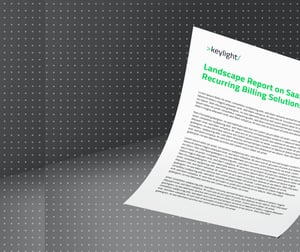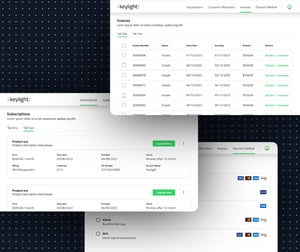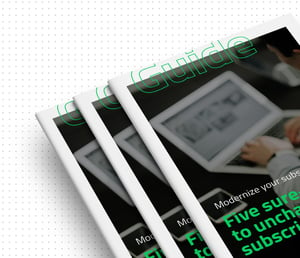The Anatomy of Subscription Businesses | Part four
 ver the last few weeks we have looked at different areas of business and how they’re being transformed by subscription business models, from health and fitness to the Internet of Things.
ver the last few weeks we have looked at different areas of business and how they’re being transformed by subscription business models, from health and fitness to the Internet of Things.
However, it’s in the energy sector that we’re seeing some of the greatest innovations, as early adopters make game-changing shifts driven by a customer-centric approach to energy as a service (EaaS).
In this article, we look at how the energy market is changing with the advent of sophisticated subscription models, and what can be done to improve the systems and processes for better business outcomes and improved customer experiences.
Redefining the usage of energy
EaaS is a particularly exciting sector at the moment. It is the apex where subscriptions, the Internet of Things, digitization, sustainability, connectivity, augmented reality, cyber security, blockchain, customer experience, and more come together. It has national, regional, and local significance, incorporating multiple entities from corporations to cities and impacting just about every individual around the world in the biggest shake-up to the grid in 100 years.
The industry is facing the same type of disruption that has already come to other sectors such as retail and transport - but arguably on a greater level, providing an immense opportunity for those who are prepared to transform.
Energy-as-a-Service (EaaS) is a delivery model that combines hardware, software, and services. Its goal is to:
- Combine demand management and energy efficiency services
- Facilitate the adoption of renewables and other decentralized supply sources
- Optimize the balance between demand and supply
The need for an EaaS model
- For customers, the benefit is in the simplicity and cost-effectiveness of use, only paying for what you actually use and lowering or eliminating upfront costs. For example, according to one survey, 72.5% of people mentioned ‘initial installation cost’ as the reason they were reluctant to install a solar power system, which currently operates on an old-fashioned lease-to-own model. With EaaS, solar power would be a pure subscription where you only pay for renewable energy, and equipment upgrades simply come as part of the package.
- For society, the benefit is in increased sustainability and the easy adoption of renewable energy resources.
- For businesses, EaaS offers end-to-end management of a customer's energy assets and services instead of asset-focussed, centralized power generation sold to passive consumers.
All three will benefit from the effective and accurate management of energy without waste, expanding electrification, and decarbonizing the economy.
The challenges of shifting to EaaS
The challenge for businesses in the energy sector is that shifting to EaaS requires them to change significantly to stay relevant and competitive. Key areas of transformation include:
- The shift from ownership to partnership
EaaS shifts from asset-focussed, centralized power generation and sales to end-to-end management of a customer’s energy assets and services. For utilities, companies, for example, the emphasis is on moving from owning and operating the essential physical assets to having strong capabilities in digital technologies and working with a range of partners to construct and deliver winning customer propositions. This goes beyond partnerships between businesses and hinges on a connected society as EaaS has the capacity to merge markets. - The shift from centralized generation
Energy will no longer flow in one direction to passive, rate-paying consumers. Everyone will generate as well as consume energy. Research from Deloitte said: “People will be able to manage their excess supply through peer-to-peer (P2P) markets. Energy will be bundled into customer-centric subscription models and sold as a secondary product embedded in primary products, such as ‘an electric car that has power’ or ‘a home that is warm.” - The shift to aggregate agents
With a vastly more complex energy landscape, customers will look for aggregating agents who act as a single source point for all energy requirements.
Key requirements for companies shifting to EaaS
To achieve this shift, companies need to address key requirements within their business models:
- Digitize core capabilities
Companies need to have sophisticated digital capabilities to deliver EaaS, key requirements of which are process automation, asset analytics, and field mobility applications. - Reinventing the platforms
Organizations will need to improve their use of data, enabling them to offer a wider range of services. They need to enable energy, transaction management, operations and maintenance, and optimization of all appliances and devices. - End-to-end energy solutions
As we move to a future where smart devices are embedded in public infrastructure, buildings and transport, and communication, the exchange of data will facilitate the buying and selling of energy. Companies will need to foster customer loyalty and adopt a tailored end-to-end approach to energy solutions.
The convenience provided by subscriptions for EaaS
Each of the requirements for shifting to EaaS mirror the fundamental elements of healthy subscription business models. The synergy between EaaS and subscriptions means that one can feed and facilitate the other.
Like any subscription model, with EaaS the customer doesn’t pay for the product itself, they pay for the access. However, as the infrastructure for energy as a service is so vast, and energy is both consumed and generated on macro and micro levels, it acts as a bridge between multiple markets. Best described as a smart community, EaaS is arguably the ultimate showcase for how consumers and their partners interact via their subscriptions.
Advantages for B2B businesses
At a B2B level, EaaS subscriptions facilitate financial management and environmental sustainability.
On the one hand, they can reduce the customer’s burden of all project expenses (facility, construction, operation, maintenance, etc.) because the initial investment risk and cost burden, belongs to the service provider.
On the other hand, EaaS subscription models mean companies can use eco-friendly electric power without owning expensive renewable energy facilities and concentrate on their core business.
Advantages for B2C businesses
At a B2C level, EaaS subscriptions enable individual consumers to have more control over their spending, it will provide more cost-effective energy use, and it will provide convenient access to renewable energy because they only have to bear the operational expenses instead of initial capital investment.
With EaaS, energy is increasingly produced and consumed in local, decentralized markets, it will start to resemble other peer-to-peer markets like eBay, Airbnb, or Funding Circle. That technology helps to bypass top-down supply and create platforms that can manage and monetize spare capacity in the system, through the leasing and trading of assets and outputs. The result is a more reliable, and more sustainable (environmentally and financially) energy supply for customers as well as businesses.
Identifying possible risks for EaaS models
The challenges for EaaS businesses transforming to subscription models are similar to other industries. However, the scale of the industry and its immense connectivity make it all the more complex.
As things stand, businesses find themselves in need of:
- Software to manage the vast amount of data and complex processing of that data. Currently, most digital systems are not extensive enough to process big data, and as a result, launching a subscription model takes a long time because businesses have to develop concepts and connect systems together in ways they were not originally designed to work.
- Complex usage-based billing systems that allow for user personalization and scalability of service
- Real-time metering for direct and indirect sales channels and customer self-service
- Currently, customers have little control over their assets due to outdated systems and processes. Companies need to implement decoupled systems or custom-built features for mediation, rating, and co-terming contracts and prorations.
- Some EaaS providers also provide hardware at the beginning of a contract, which requires the deployment of electric energy equipment, such as electric vehicles (EVs) and grid-connected water heaters.
Support and scale an EaaS subscription
The complexity of the industry places higher stakes on the risks of getting it wrong, it also means that the benefits of the right solutions offer greater opportunity for the business to create market awareness.
At keylight, our subscription business platform offers all the functionality for EaaS businesses to launch and scale successfully. Key solutions for the industry’s specific challenges include:
End-to-end architecture
Central to streamlining the demand and supply operations of EaaS is choosing a system that has a unified data model to act as the backbone for the subscription ecosystem.
- A headless system with frontend applications allows energy businesses to continuously optimize the experience for all users without disrupting the backend.
- Within the frontend applications, users are given access to manage quotes and invoices. Customers can also meter and manage their usage and make changes to their plans in their own portal.
- The native connectivity between applications and the central platform solves the complexity and integration challenges with other CRM and ERP systems.
- Businesses can build their own applications on top of the central platform to enable even more use cases.
Recurring billing
Billing is where many subscription models come unstuck because the systems are designed from a financial or transactional mindset rather than thinking about how users need to interact with usage data.
A system that’s designed with refined mathematical logic that turns complexity into manageable steps on the user interface, improving the billing experience for not just the customer but also every user group that needs to interact with the billing operations.
A modern system with a modern mindset
An end-to-end approach to subscription systems is one of the defining features of a healthy subscription model, including everything from capturing the right data and handling customer insights to robust integrations for tax and other business solutions.
At keylight, everything is built with users in mind and 80% of requirements can be fulfilled out-of-the-box, so there is little customization work and integration pain to contend with. By choosing systems that are fit for purpose from start to finish, rather than trying to integrate or adapt legacy platforms, you minimize challenges and maximize business outcomes.
In this particular industry, which is so clearly going to continue to evolve at pace, you also set your business up in a way that’s designed to evolve and compete at the cutting edge going forward, leaving more time for innovation and less time fixing costly retrospective pain points.
Building a reliable and sustainable future with EaaS
Perhaps the most poignant thing about EaaS is that it’s absolutely clear to anyone entering into or transforming within the energy space that what businesses do today has to be done with the future in mind. So much of this industry is about understanding the market, the possibilities, and the customer, all of which hinges on the sophisticated use of data.
While right now people might hesitate to purchase an electric car, for example, because they are highly expensive and the infrastructure (electric charge points) is not universally reliable or available, EaaS is an industry that seeks to shift the entire infrastructure rather than a single service. It will make renewables more accessible - it’s about being part of a revolutionary change.
As a result, energy businesses should not have a system that means they are tied to building complex concepts and workarounds. They need a system that enables them to leverage the benefits of a digital subscription business, such as engaging with customers, collecting insightful usage data, and creating awareness around the sector and sustainability.

Simplify the usage of energy
with one subscription system
Start now with >keylight/




